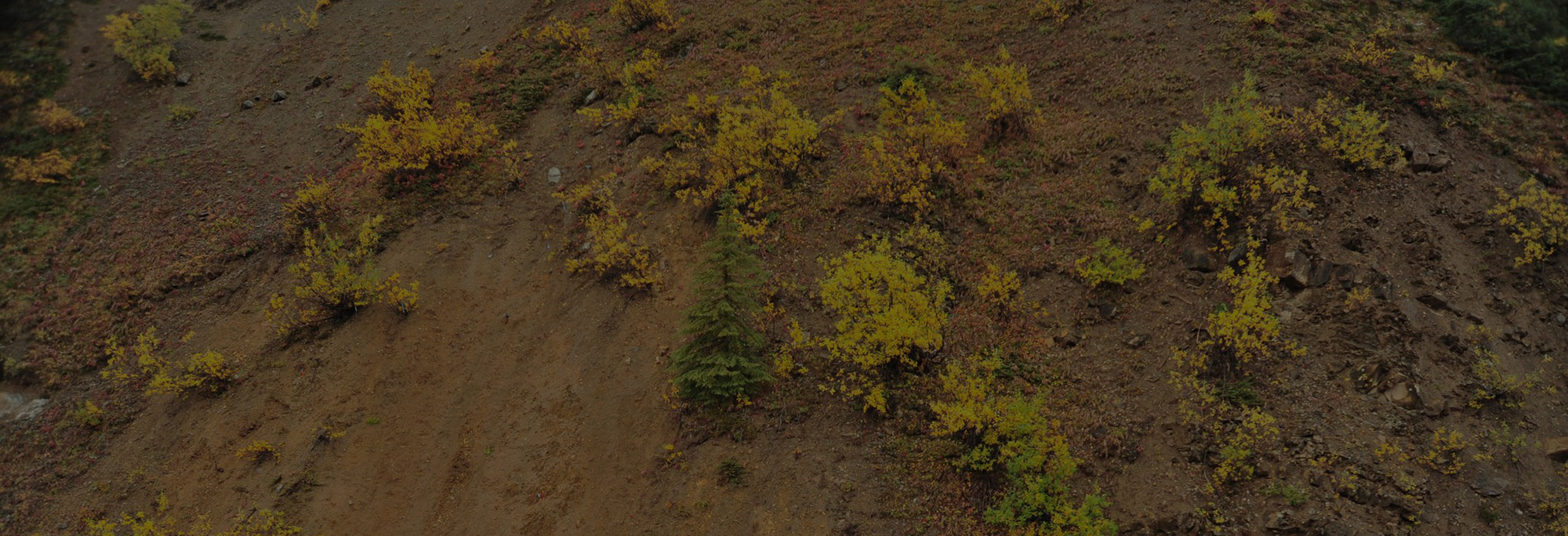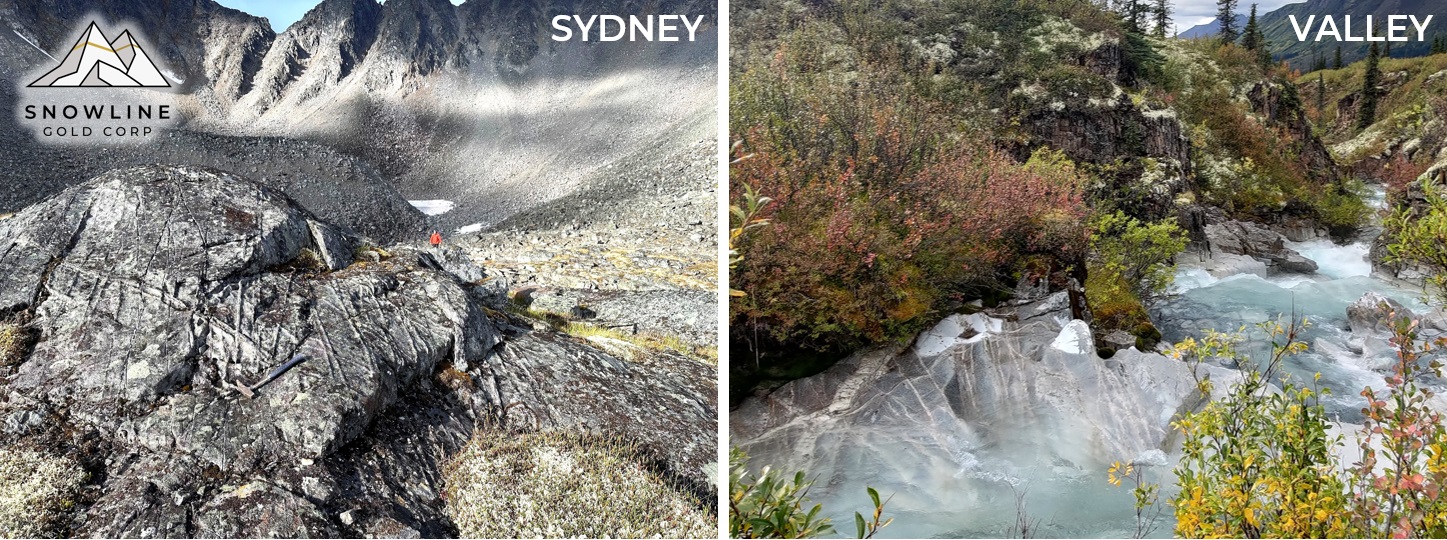- Three additional new reduced intrusion-related gold system targets established on the Rogue Project, with an additional fourth target discovered on the Cynthia Project.
- Continuous outcrop samples yield up to 5.12 g/t Au over 3.3 m at the Livia target, Rogue Project, and 2.93 g/t Au over 2.0 m at the Sydney target, Cynthia Project.
- Visible gold in sheeted veins discovered in outcrop in a newly identified intrusion at the Ramsey target, Rogue Project, with an outcrop grab sample of 86.5 g/t Au.
Vancouver, B.C., May 2, 2024: SNOWLINE GOLD CORP (TSX-V: SGD) (OTC: SNWGF) (the “Company” or “Snowline”) is pleased to announce discovery of three new reduced intrusion related gold system (RIRGS) targets at its Rogue Project and an additional new RIRGS target at its adjacent Cynthia Project in the Yukon Territory, Canada. Analytical results from the Company’s 2023 surface exploration program demonstrate widespread gold mineralization and RIRGS pathfinder elements associated with intrusions of the Rogue Plutonic Complex, a 60 x 30 km geological feature which also hosts the Company’s flagship Valley target. Results include outcrop chip sampling to 5.12 g/t Au over 3.3 m at the Livia target, and selective outcrop grab samples to 86.5 g/t Au at the Ramsey target. The new RIRGS targets are described in more detail below.

Figure 1 – Map of the Rogue Project and northern Cynthia Project, showing the locations of the newly identified RIRGS targets in relation to Valley and certain additional targets. The new discoveries highlight the widespread geographical footprint of gold mineralization at the Rogue Project, which effectively covers the entire Rogue Plutonic Complex.
“While consistent drill results have dominated our headlines, Snowline’s regional surface exploration team has done exemplary work behind the scenes bolstering our exploration pipeline and demonstrating widespread gold fertility within the regional-scale Rogue Plutonic Complex,” said Scott Berdahl, CEO & Director of Snowline. “The presence of our Valley discovery shows that the geological ingredients needed to produce a uniquely robust form of RIRGS mineralization are present at Rogue. The results of our regional work suggest a strong potential for locating other such instances of gold endowment across much of the broader, >1,100 km2 project area. With essentially the entire Rogue Plutonic Complex under full ownership, we are thrilled to have the opportunity to systematically explore this nascent gold district, along with the resources and the team to make the most of this opportunity.”
LIVIA TARGET, ROGUE PROJECT
The Livia target comprises a cluster of at least three mineralized zones located roughly 3 km east of the Company’s newly identified Aurelius target (see Snowline press release dated February 20, 2024) and 1-2 km west of the mid-Cretaceous Old Cabin pluton. The newly discovered gold mineralization occurs both within sheeted quartz veins hosted in <1 km diameter outcropping granodiorite stocks, and within silicified country rock (Figure 2).
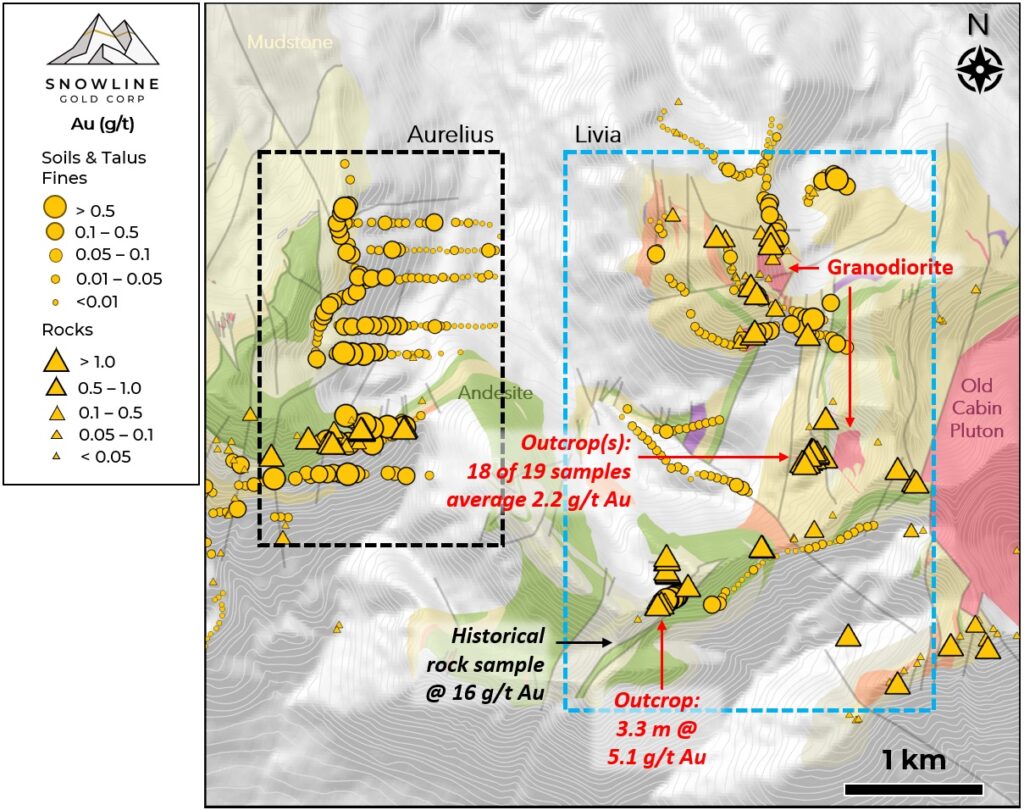
Figure 2 – Plan view of the Aurelius and Liva targets, showing the known extent of anomalous gold values in surface geochemistry and the location of various rock samples. Zones of elevated to anomalous gold mineralization are present across an open 4 x 2.5 km area, centered roughly 3 km east of Snowline’s Aurelius target.
Historical surface sampling of silicified country rock near the south end of Livia returned grab samples of up to 16 g/t Au. Follow up by the Company identified a 1000 x 300 m northeast-trending structural corridor defined by two parallel structures hosted in mudstone and volcanic rocks, extending northeast from the historical sample site. A continuous rock chip sample from the southernmost fault hosted in silicified mudstone returned 3.3 m @ at 5.12 g/t Au including 0.3 m @ at 14.40 g/t Au (and 39.9 g/t Ag) with similar silicification and pathfinder element association to the Aurelius target. Additional selective rock chip samples from 200 m to the northeast within the same corridor returned seven mineralized vein samples out of eight with an average of 4.47 g/t Au (up to 7.39 g/t Au).
Serendipitously, the granodiorite stocks at Livia were initially identified and mapped by Snowline’s Chair Dr. Craig Hart during the field component of his undergraduate Honours thesis, before his role in developing the RIRGS deposit model. The stocks are hosted by the same volcanic and sedimentary rocks hosting mineralization at Aurelius and are located between steep NW-SE and N-S structures. Mineralization is characterized by sheeted quartz vein arrays with arsenopyrite and galena. A 110 x 50 m corridor of sheeted veins, with a vein density up to five veins per meter, was identified in one of these granodiorite stocks. This showing returned 18 mineralized vein samples out of 19 (Figure 2), hosted both in granodiorite and the surrounding hornfels lithologies, with an average of 2.22 g/t Au (up to 7.17 g/t Au, and 41.4 g/t Ag).
SYDNEY TARGET, CYNTHIA PROJECT
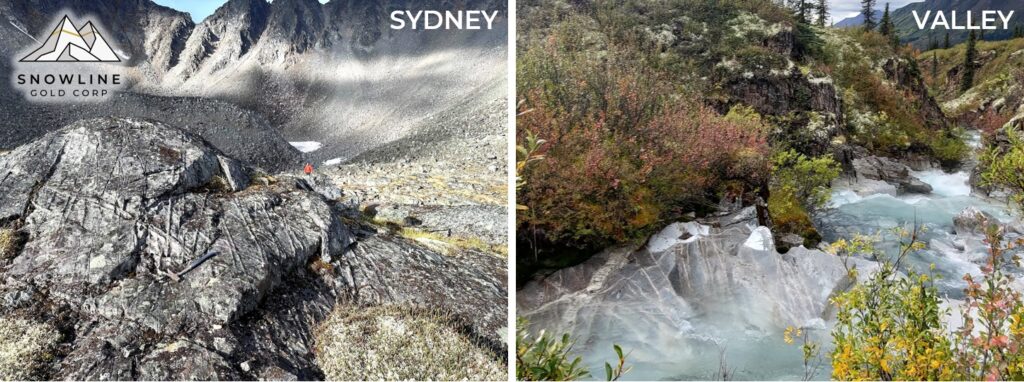
Figure 3 – High quartz vein densities with multiple vein orientations in outcrop at the Cynthia Project’s Sydney target (left) and the Rogue Project’s Valley target (right), highlighting similarities between the two. The poly-phase nature of the intrusion at Valley is thought to be a key factor in the formation of the multiple quartz vein generations and the high gold grades encountered there in drilling. This observation adds to the traditional RIRGS model, suggesting that earlier phases of an intrusion can serve as receptive host rocks for mineralization introduced by later phases. Thus, larger intrusions—like that at Sydney—previously thought to be too deeply eroded to be prospective for high-density RIRGS gold mineralization could potentially be mineralized internally by later intrusive phases.
The Sydney target is a newly discovered, open, 250 x 200 m zone of sheeted quartz veins hosted in a 3 km diameter granodiorite stock. The target is hosted in a N-S structural corridor with subvertical faults with up to 26 veins per meter. This zone returned a 2.0 m chip sample at 2.93 g/t Au, a 2.8 m chip sample at 0.53 g/t Au and a selective rock sample with 8.01 g/t Au. The rest of the target is characterized by an average of 10 veins per meter.
A second granodiorite stock located on the Cynthia Project remains largely unexplored.
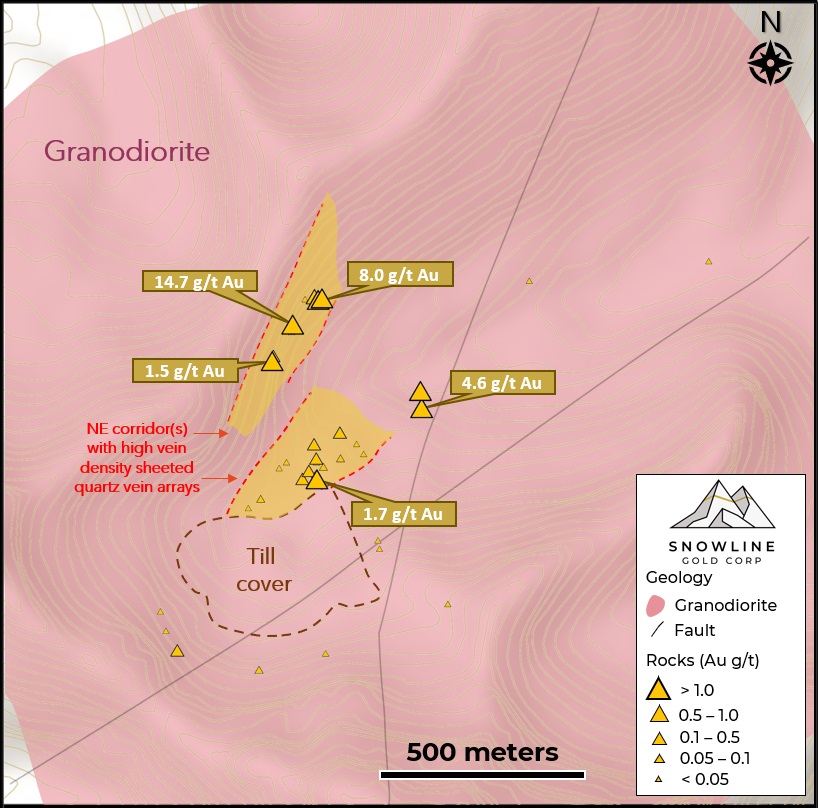
Figure 4 – Plan view of the Sydney target, with exposed zones of high quartz vein densities highlighted in yellow and select rock grab samples labeled. The 14.7 g/t Au sample is local float (non bedrock) material.
RAMSEY TARGET, ROGUE PROJECT
Like Valley, the Ramsey target occupies a topographical low, with limited outcrop and a large component of transported surface cover. The target, located 23 km west of Valley (Figure 1), was initially identified as a magnetic high anomaly in historical aerial magnetic data. Surface investigation revealed the presence of low density (~1 vein/m) sheeted quartz veins in an intrusive host rock, with outcropping bismuth minerals and visible gold observed in the veins.
Out of ten grab samples collected from the isolated outcrops, which occupy only a small (~ 60 x 30 m) portion of the broader 4 x 2 km magnetic anomaly, eight were mineralized, with an average grade of 0.53 g/t Au not including a visible gold bearing grab sample of quartz vein material with abundant bismuthinite which returned 86.5 g/t Au. A soil sample grid established over the area returned elevated (>10 ppb Au) background gold values and localized anomalies up to 105 ppb Au associated with elevated bismuth and tellurium. It is unclear to what extent transported surface material (tills, colluvium and alluvium) might be masking bedrock influence on soil geochemistry across the target.
DUKE TARGET, ROGUE PROJECT
Duke is a newly discovered RIRGS target characterized by a 1,500 x 1,000 m granodiorite stock partially covered by colluvium and moraine deposits, located roughly 11 km southeast of the Valley target (Figure 1). Duke exhibits a similar geophysical response in historical ZTEM data to Valley, with a resistive anomaly marking the location of the intrusion.
Initial reconnaissance work identified sheeted quartz-sulphide veins with densities consistently greater than 10 veins per meter over an open, 500 x 350 m area. The vein mineralogy is characterized by quartz-carbonate with pyrrhotite, bismuthinite, and arsenopyrite. The vein sets are mapped as vertical with NW-SE and E-W orientation and have the potential to extend beneath the moraine deposits. Initial, representative grab samples returned values up to 0.56 g/t Au in outcrop and 0.91 g/t Au in float. These results are seen as encouraging indicators of fertility, and the target itself extends the known gold endowment along a general NW-SE corridor to >25 km stretching from Aurelius in the northwest and including the Valley target.
OTHER TARGETS
In addition to the new targets described above, the Company identified a zone of abundant gold-bearing intrusive float in glacial till on the Rogue Project roughly 12 km down-valley from (west-northwest of) the Valley gold discovery, associated with locally anomalous (17, 237 and 768 ppb Au) stream sediment geochemistry. It is unclear at present whether this float is derived from an undiscovered mineralized intrusion or whether it could have been transported as till from the Valley target itself at high enough concentrations to produce the observed gold anomalies in stream geochemistry.
Additional targets, including the Rogue Project’s JP target (formerly “Scronk”) and others, were advanced by the Company during the 2023 field season and could potentially see drill testing in 2024.
ABOUT SNOWLINE GOLD CORP.
Snowline Gold Corp. is a Yukon Territory focused gold exploration company with an eight-project portfolio covering >360,000 ha (>3,600 km2). The Company is exploring its flagship >110,000 ha (>1,100 km2) Rogue gold project in the highly prospective yet underexplored Selwyn Basin. Snowline’s project portfolio sits within the prolific Tintina Gold Province, host to multiple million-ounce-plus gold mines and deposits including Kinross’s Fort Knox Mine, Newmont’s Coffee deposit, and Victoria Gold’s Eagle Mine. The Company’s first-mover land position and extensive database provide a unique opportunity for investors to be part of multiple discoveries and the creation of a new gold district.
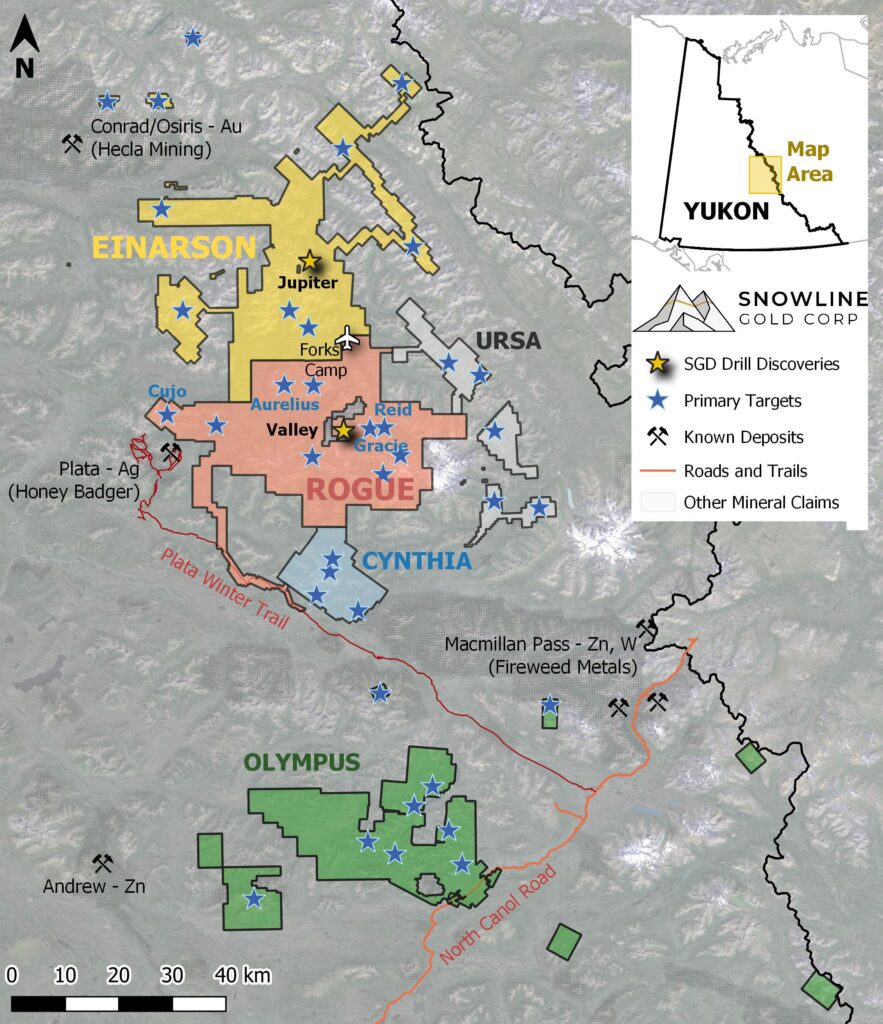
Figure 5 – Project location map for Snowline Gold’s eastern Selwyn Basin properties: Rogue, Einarson, Ursa, Cynthia and Olympus. The Valley target is one of several prospective reduced intrusion-related gold system (RIRGS) targets on the broader 30 x 60 km Rogue Project, complemented by orogenic, Carlin-type, RIRGS and other sediment hosted gold targets on surrounding projects.
QUALIFIED PERSON
Information in this release has been prepared under supervision of and approved by Thomas Branson, M.Sc., P. Geo., VP Exploration of Snowline Gold Corp, as Qualified Person for the purposes of National Instrument 43-101.
ON BEHALF OF THE BOARD
Scott Berdahl
CEO & Director
For further information, please contact:
Snowline Gold Corp.
+1 778 650 5485
info@snowlinegold.com
Neither TSX Venture Exchange nor its Regulation Services Provider (as that term is defined in policies of the TSX Venture Exchange) accepts responsibility for the adequacy or accuracy of this release.
CAUTIONARY NOTE REGARDING FORWARD-LOOKING STATEMENTS
This news release contains certain forward-looking statements, including statements regarding the consolidation of the Einarson Project, the acquisition of the Venus target, the significance of analytical results, the prospectivity of various gold targets, and the potential for investors to participate in multiple future discoveries, the creation of a new gold district and the Company’s future plans and intentions. Wherever possible, words such as “may”, “will”, “should”, “could”, “expect”, “plan”, “intend”, “anticipate”, “believe”, “estimate”, “predict” or “potential” or the negative or other variations of these words, or similar words or phrases, have been used to identify these forward-looking statements. These statements reflect management’s current beliefs and are based on information currently available to management as at the date hereof.
Forward-looking statements involve significant risk, uncertainties and assumptions. Many factors could cause actual results, performance or achievements to differ materially from the results discussed or implied in the forward-looking statements. Such factors include, among other things: risks related to uncertainties inherent in drill results and the estimation of mineral resources; and risks associated with executing the Company’s plans and intentions. These factors should be considered carefully, and readers should not place undue reliance on the forward-looking statements. Although the forward-looking statements contained in this news release are based upon what management believes to be reasonable assumptions, the Company cannot assure readers that actual results will be consistent with these forward-looking statements. These forward-looking statements are made as of the date of this news release, and the Company assumes no obligation to update or revise them to reflect new events or circumstances, except as required by law.
